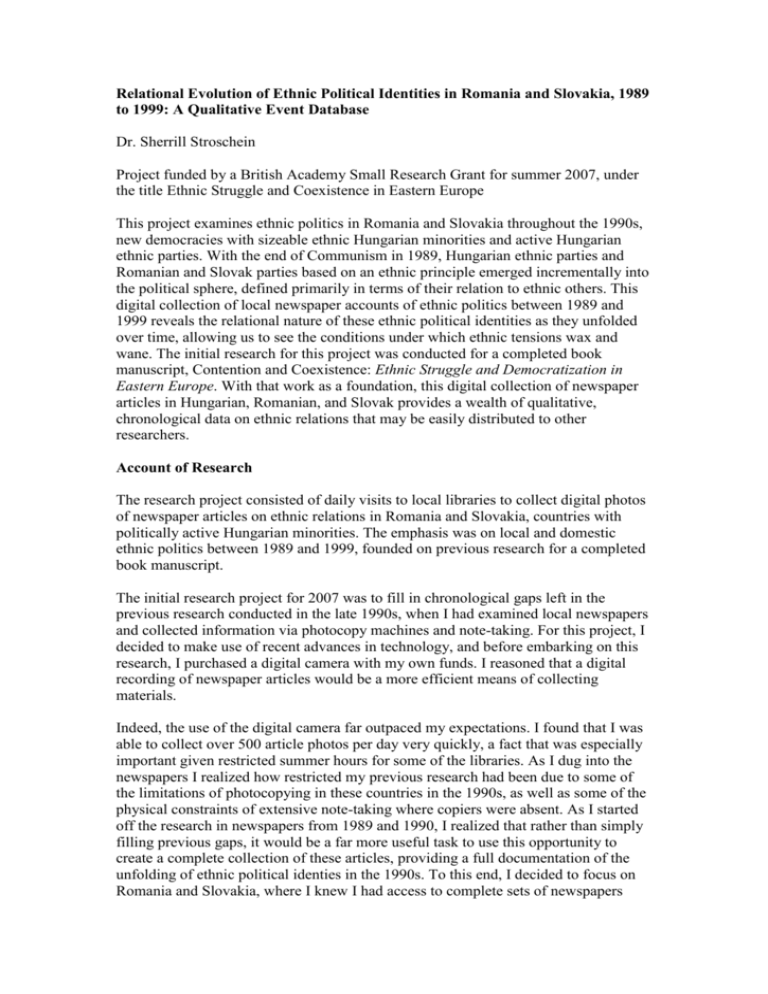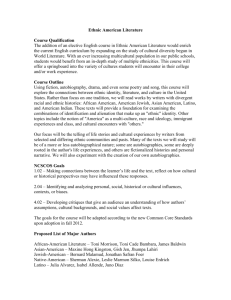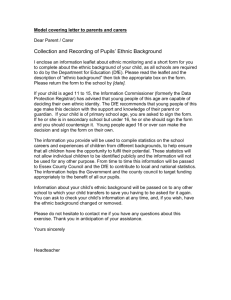Relational Evolution of Ethnic Political Identities in Romania and
advertisement

Relational Evolution of Ethnic Political Identities in Romania and Slovakia, 1989 to 1999: A Qualitative Event Database Dr. Sherrill Stroschein Project funded by a British Academy Small Research Grant for summer 2007, under the title Ethnic Struggle and Coexistence in Eastern Europe This project examines ethnic politics in Romania and Slovakia throughout the 1990s, new democracies with sizeable ethnic Hungarian minorities and active Hungarian ethnic parties. With the end of Communism in 1989, Hungarian ethnic parties and Romanian and Slovak parties based on an ethnic principle emerged incrementally into the political sphere, defined primarily in terms of their relation to ethnic others. This digital collection of local newspaper accounts of ethnic politics between 1989 and 1999 reveals the relational nature of these ethnic political identities as they unfolded over time, allowing us to see the conditions under which ethnic tensions wax and wane. The initial research for this project was conducted for a completed book manuscript, Contention and Coexistence: Ethnic Struggle and Democratization in Eastern Europe. With that work as a foundation, this digital collection of newspaper articles in Hungarian, Romanian, and Slovak provides a wealth of qualitative, chronological data on ethnic relations that may be easily distributed to other researchers. Account of Research The research project consisted of daily visits to local libraries to collect digital photos of newspaper articles on ethnic relations in Romania and Slovakia, countries with politically active Hungarian minorities. The emphasis was on local and domestic ethnic politics between 1989 and 1999, founded on previous research for a completed book manuscript. The initial research project for 2007 was to fill in chronological gaps left in the previous research conducted in the late 1990s, when I had examined local newspapers and collected information via photocopy machines and note-taking. For this project, I decided to make use of recent advances in technology, and before embarking on this research, I purchased a digital camera with my own funds. I reasoned that a digital recording of newspaper articles would be a more efficient means of collecting materials. Indeed, the use of the digital camera far outpaced my expectations. I found that I was able to collect over 500 article photos per day very quickly, a fact that was especially important given restricted summer hours for some of the libraries. As I dug into the newspapers I realized how restricted my previous research had been due to some of the limitations of photocopying in these countries in the 1990s, as well as some of the physical constraints of extensive note-taking where copiers were absent. As I started off the research in newspapers from 1989 and 1990, I realized that rather than simply filling previous gaps, it would be a far more useful task to use this opportunity to create a complete collection of these articles, providing a full documentation of the unfolding of ethnic political identies in the 1990s. To this end, I decided to focus on Romania and Slovakia, where I knew I had access to complete sets of newspapers over the 10-year period. I decided not to pursue further research in Transcarpathia, Ukraine, where flood damage and some institutional irregularities have eliminated the possibility of obtaining a complete set of local newspapers. The digital article project thus includes four “streams” of newspapers from Romania over the 10-year period: Romanian and Hungarian local newspapers in Cluj (a Romanian-majority city) and Romanian and Hungarian local newspapers in Târgu Mureş (a 50-50 city that experienced a riot between these groups in 1990). It also includes two “streams” of state-level newspapers in Slovakia over the 10-year period, one in Slovak and one in Hungarian. 1. Romania: I visited two cities in Romania for this purpose: Cluj and Târgu Mureş. In Cluj, I made use of the local county library for newspapers after 1993 and the university library for newspapers between 1989 and 1992. The local newspapers examined in Cluj were Adevărul de Cluj in Romanian and Szabadság in Hungarian, both available across the 10-year period of study. In Târgu Mureş, I used the county library for access to the local newspapers, Cuvîntul Liber in Romanian and Népújság in Hungarian. Particular attention was given to the dual accounts of a local ethnic riot in 1990. 2. Slovakia: The vast majority of time in Slovakia was spent examining state-level newspapers. Previous research in Slovakia had produced a quite complete collection of information from two local city settings, the Hungarian-majority city of Komárno and the relatively ethnically-balanced city of Rimavská Sobota. One week was spent filling in gaps in this research for the purposes of updating the book manuscript. However, given the state of Slovak local media in the 1990s, I had always found this information rather incomplete with regard to the contentious nature of ethnic politics in Slovakia at that time. For this reason, the majority of time was spent in the Comenius University Library in Bratislava, examining two newspapers over a 10-year period: the Hungarian-language daily Új Szó and the Slovak Smena, then Sme. This examination provides good, comprehensive coverage of both views of political events with ethnic implications as they unfolded. Advances in Knowledge There are two primary means by which this project advances knowledge. The first is methodological, and the second relates to our understanding of ethnic political dynamics. 1. Methodological and Research-oriented This collection of articles represents a qualitative database of events from which researchers might draw for their own work. Event analysis often involves a long process of coding of actions to reduce complex information into more manageable units, as I have done in the Contention and Coexistence book manuscript. However, in order for other scholars to assess or replicate the coding, it is important to have the original information available. Digital photo technology makes this possible. Throughout the years I have occasionally received requests to share my photocopied newspapers. I now can provide colleagues with a more complete and digital version of information. A chronological index of the photos is being prepared for placement on the web, and interested researchers might contact me for the digital article photos free of charge, with the provision of hardware to receive the files. The overall database is currently 28 gigabytes, so researchers would be encouraged to be quite specific regarding the time period of articles they wish to request. 2. Understanding Ethnic Political Dynamics Ethnic politics is a complex phenomenon because it emerges relationally, as noted by Rogers Brubaker in his 1996 book Nationalism Reframed. An ethnic “us” only makes sense when defined in relation to an ethnic “them.” For this reason, it is important to examine both sides of ethnic political debates where possible, to understand how groups define themselves in relation to each other and how ethnic political demands might shift over time. An examination of newspaper streams over a 10-year period in relation to each other provides an excellent means to examine these dynamics. The fall of Communism in 1989 provided a unique opportunity to watch how social actors began to contest on an open political field for the first time in decades, including the incremental emergence of Hungarian ethnic parties, as well as Romanian and Slovak parties defined on an ethnic principle. Some social science literature has prioritized the role of international actors in ethnic relations, partly because it may be less time-consuming to collect information on foreign policy than on domestic political debates across a 10-year period. Thus, overall there has tended to be more research on such international aspects than on domestic aspects, given more readily available data. This project is a step in shifting that trend, as the collection of articles creates a foundation on which other researchers interested in these domestic debates might build.








